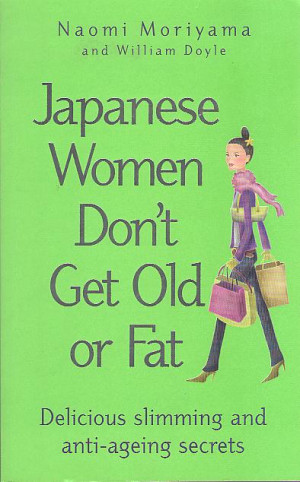My response to the title of this book? I wish!
Is this another book to make women feel bad? Certainly the title is, as are most books extolling the virtues of someone else’s diet (the French, Mediterranean). But if you go beyond the unappetising, derivative title, this book suggests useful ways to adopt good Japanese diet principles.
The book seems to be directed at an audience with little or no knowledge of Japanese cuisine, but Chapter 4, ‘How to Start Your Tokyo Kitchen’ and the numerous recipes throughout the book are helpful, not just for those for whom Japanese food is new territory. While we have not trialled any of the recipes, Kei thinks they are ‘easy to try.’ One of the problems with attempting Japanese home cooking is the perceived degree of difficulty, but the authors certainly debunk this myth.
Apart from the down to earth kitchen and cooking hints, the book reduces Japanese diet principles into palatable sized lists (seven seems to be the lucky number). For example, the seven ‘Pillars’ of Japanese home cooking are simplified to-consume more fish, vegetables rice, soya (soy bean products), noodles, tea and fruit. But these pillars are not particularly new or original-they form the basis of good eating habits generally. Also, one very large omission-the importance of shun 旬 or seasonality in Japanese food. It’s mentioned only in passing, but this macro-biotic principle of eating what’s in season is a cornerstone of Japanese cuisine.
If there is just one message to take away from this book, it is the second of the seven ‘secrets’ of the Japanese diet-eat small portions (Chapter 2). Living in Australia, I notice most the disparity between the sizes of the average Aussie meal vs the Japanese meal. A ‘full meal’ in Australia refers to its size, whereas ‘full’ refers to variety and the number of (small) dishes in the Japanese context. And presentation, the use of empty space on the plate or dish, is not just about Japanese aesthetics, but a way to eat less, according to this book.
While successfully shattering the high cuisine image of Japanese cooking, the book unfortunately perpetuates a greater myth-that ‘Japanese Women Don’t Get Old or Fat’. There is no scientific basis to support this assertion, certainly none in the book, and attempts to present any evidence behind this throwaway line is at best, dubious.
One example: in the middle of the introduction presenting statistics on obesity and life expectancy, the authors make a curious statement, ‘Japan has become the Land of Immortal Women’. Another throwaway bit of hype perhaps, but while Japanese women’s life expectancy may be the longest in the world, Australia’s average life expectancy, where there is a growing obesity problem, is very close on Japan’s heels. Perhaps what’s most telling is what’s not told-that 25 percent of Japanese are obese or overweight. That’s pretty high, and certainly higher than South Korea weighing in at a paltry 3.2 percent, where the diet is very different from the Japanese.
by Masako Fukui, Copyright Kei’s Kitchen
Japanese Women Don’t Get Old or Fat by Naomi Moriyama and William Doyle, originally published in 2005
Check out the author’s webpage, which has wonderful information and insights into living, eating, and caring.

